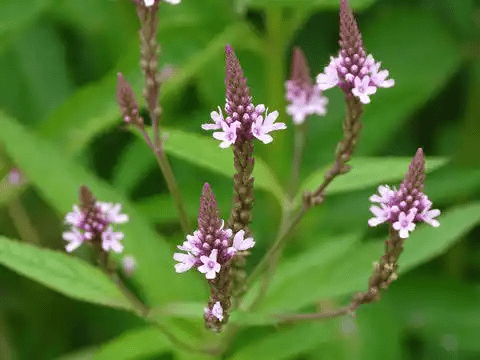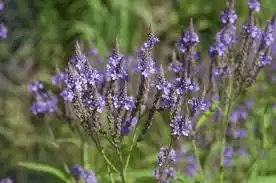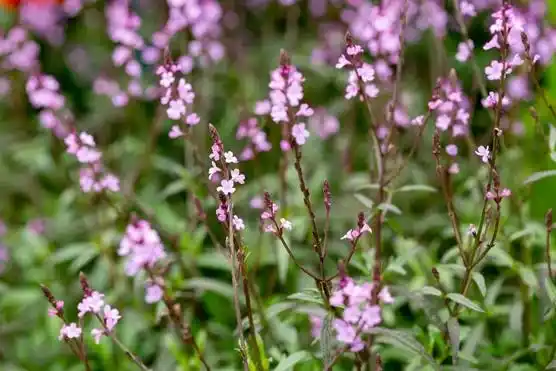Verbena officinalis, commonly known as common vervain, is a perennial herbaceous plant that holds a special place in the world of herbalism and traditional medicine. Belonging to the Verbenaceae family, this species of verbena is distinguished by its slender, erect stems, opposite leaves with serrated edges, and clusters of small, tubular flowers that vary in color from pale lilac to violet.
This herb has a storied history dating back centuries, with its usage deeply rooted in different cultures. The botanical name “officinalis” signifies its historical recognition as a medicinal plant with established uses.
Common vervain has been a staple in herbal remedies, and its reputation as a healing herb has been acknowledged in various traditional systems of medicine.
One of the notable aspects of Verbena officinalis is its association with stress relief and relaxation. Traditional herbalists have often utilized the plant to create infusions or tinctures believed to have calming properties.
In this context, common vervain has been historically employed to alleviate nervous tension, anxiety, and even insomnia. The calming effects are attributed to the presence of certain compounds in the plant, which interact with the nervous system.
Beyond its role in promoting mental well-being, Verbena officinalis has been recognized for its potential digestive benefits. The plant is thought to stimulate the digestive system, making it useful in addressing issues such as indigestion and bloating.
Herbal preparations, including teas or extracts made from common vervain, have been employed to support digestive health in traditional practices.
In addition to its internal applications, common vervain has found use in skincare. Some cultures have employed the herb for its potential to promote skin health, addressing issues like minor irritations or blemishes. The herb’s astringent properties are believed to contribute to its skin-soothing effects.
Cultivating Verbena officinalis is relatively straightforward, making it a feasible addition to herb gardens. This plant thrives in well-drained soil and prefers full sunlight, characteristics that make it adaptable to various growing conditions.
Its hardiness and resilience have contributed to its widespread cultivation for both ornamental and medicinal purposes.
While common vervain has a rich history in traditional medicine, it’s essential to note that herbal remedies should be approached with caution and, when needed, under the guidance of knowledgeable practitioners.
Scientific research on the plant’s properties is ongoing, providing insights into its potential benefits and applications.
In summary, Verbena officinalis, or common vervain, is a noteworthy herb with a legacy rooted in traditional medicine. Its slender stems, serrated leaves, and clusters of tubular flowers not only contribute to its visual appeal but also underscore its historical significance as a medicinal plant.
From stress relief to digestive support, common vervain continues to be a valued herb in the world of herbalism and natural remedies.
The Botanical Description of Verbena officinalis
1. Life: Verbena officinalis, commonly known as Vervain or Common Verbena, is a perennial herbaceous plant belonging to the Verbenaceae family. It exhibits a robust and upright growth habit, with stems that can reach heights of about 30 to 90 centimeters.
2. Leaves: The leaves of Verbena officinalis are opposite, meaning they grow in pairs on opposite sides of the stem. They are lanceolate, serrated along the edges, and typically measure 5 to 10 centimeters in length. The leaves contribute to the overall aesthetic appeal of the plant.
3. Flowers: The inflorescence of Verbena officinalis consists of slender spikes bearing tiny, tubular flowers. The flowers are arranged in whorls along the spikes and are usually a delicate shade of lilac or violet. The bloom period occurs during the summer months, attracting pollinators such as bees and butterflies.
4. Stem: The stem of Verbena officinalis is square-shaped, a common characteristic of plants in the mint family. The square stem is sturdy and helps the plant maintain an upright posture.
5. Root System: Verbena officinalis develops a fibrous root system that aids in nutrient absorption from the soil. The roots anchor the plant securely and contribute to its resilience.
The Geographic Distribution of Verbena officinalis
1. Native Habitat: Verbena officinalis is native to Europe but has become naturalized in various parts of North America, Asia, and Africa. It thrives in a range of habitats, including meadows, fields, and disturbed areas.
2. Preferred Conditions: This species of Verbena prefers well-drained soils and is often found in sunny or partially shaded locations. It can tolerate different soil types and is adaptable to a variety of environmental conditions.
3. Global Spread: Due to its ornamental value and traditional uses, Verbena officinalis has been introduced to new regions worldwide. It is now cultivated in gardens and landscapes for its aesthetic appeal and medicinal properties.
4. Invasive Potential: In some areas, Verbena officinalis has displayed invasive tendencies, spreading rapidly and outcompeting native vegetation. This adaptability has led to its classification as an invasive species in certain regions.
The Chemical Composition of Verbena officinalis
1. Essential Oils: Verbena officinalis contains essential oils, including citral, limonene, and geraniol. These oils contribute to the plant’s distinctive fragrance and may have therapeutic properties.
2. Iridoids: Iridoids are secondary metabolites found in Verbena officinalis. These compounds have been studied for their potential anti-inflammatory and antioxidant effects.
3. Flavonoids: Verbena officinalis is rich in flavonoids, such as apigenin and luteolin. Flavonoids have antioxidant properties that contribute to the plant’s ability to combat oxidative stress.
4. Tannins: Tannins, known for their astringent properties, are present in Verbena officinalis. These compounds may contribute to the plant’s traditional use in herbal medicine.
5. Verbascoside: Verbascoside is a phenylethanoid glycoside found in Verbena officinalis. It has been studied for its potential anti-inflammatory and neuroprotective effects.
6. Alkaloids: Some alkaloids may be present in Verbena officinalis, contributing to the overall chemical diversity of the plant.
Read Also: 16 Medicinal Health Benefits Of Sorrel (Rumex acetosa)
The Medicinal Health Benefits Of Verbena officinalis (common vervain)

1. Digestive Aid: Verbena officinalis has been traditionally recognized for its digestive benefits. The plant may help alleviate digestive issues, including indigestion and bloating, promoting overall digestive wellness.
2. Calming Properties: The calming effects of Verbena officinalis make it a valuable ally in managing stress and anxiety. It may help soothe the nervous system, promoting a sense of tranquility.
3. Anti-Inflammatory Benefits: Verbena officinalis exhibits anti-inflammatory properties, which can be beneficial for conditions such as arthritis. It may assist in reducing inflammation and associated discomfort.
4. Respiratory Support: The plant has potential respiratory benefits, acting as an expectorant and aiding in conditions like bronchitis. Verbena officinalis may facilitate the removal of mucus from the respiratory tract.
5. Immune System Boost: Certain compounds in Verbena officinalis may support the immune system, enhancing the body’s ability to defend against infections and illnesses.
6. Antioxidant Effects: Verbena officinalis is rich in antioxidants, which help combat oxidative stress and protect cells from damage caused by free radicals.
7. Sleep Aid: The calming properties extend to promoting better sleep. Verbena officinalis may be beneficial for individuals struggling with insomnia or irregular sleep patterns.
8. Anti-anxiety Effects: In addition to general calming, Verbena officinalis may specifically address symptoms of anxiety, providing relief to those experiencing heightened stress levels.
9. Skin Health: The anti-inflammatory and antioxidant properties contribute to skin health. Verbena officinalis may address conditions such as eczema and promote an overall healthy complexion.
10. Headache Relief: Verbena officinalis has been traditionally used to alleviate headaches. Its calming effects may help reduce tension and ease headache symptoms.
The Methods of Usage to Achieve the Provided Health Benefits Of Verbena officinalis (common vervain)
1. Verbena Tea: Brewing Verbena officinalis leaves into a tea is a popular and effective method to enjoy its medicinal benefits. This can promote digestive health, calm the nerves, and support respiratory wellness.
2. Tinctures: Verbena officinalis tinctures, created by extracting the plant’s compounds in alcohol, offer a concentrated form of its medicinal properties. These can be added to beverages or taken directly for a convenient consumption method.
3. Aromatherapy: Utilizing Verbena officinalis essential oil in aromatherapy can help achieve calming and anti-anxiety effects. Diffusing the oil or adding a few drops to a bath can contribute to relaxation.
4. Infusions for Skin: Creating infusions with Verbena officinalis and applying them topically can benefit skin health. This method is suitable for addressing skin conditions and promoting a healthy complexion.
5. Herbal Smoking Blends: While less common, Verbena officinalis leaves have been used in herbal smoking blends. This method is not recommended for everyone, and caution should be exercised.
6. Capsules or Supplements: Verbena officinalis supplements in the form of capsules or tablets offer a convenient way to incorporate its medicinal benefits into a daily routine.
7. Culinary Uses: Some varieties of Verbena officinalis are suitable for culinary purposes. Adding Verbena leaves to salads or using them as a flavorful herb in cooking can provide mild medicinal benefits.
The Side Effects Of Using Verbena officinalis Medicinal Plant
1. Allergic Reactions: Some individuals may experience allergic reactions to Verbena officinalis, including skin irritation or respiratory symptoms. A patch test is recommended before widespread use.
2. Pregnancy and Breastfeeding: Pregnant or breastfeeding individuals should consult healthcare professionals before using Verbena officinalis, as its safety during these periods is not well-established.
3. Interactions with Medications: Verbena officinalis may interact with certain medications. Individuals taking prescribed drugs should consult their healthcare provider before using Verbena supplements or remedies.
4. Photosensitivity: Some individuals may experience increased sensitivity to sunlight after using Verbena officinalis topically. Caution should be exercised to avoid prolonged sun exposure.
5. Gastrointestinal Discomfort: In some cases, Verbena officinalis may cause mild gastrointestinal discomfort. Individuals with sensitive digestive systems should use it cautiously.
6. Not Suitable for Children: Verbena officinalis supplements or remedies may not be suitable for young children, and consultation with a healthcare provider is advised.
7. Avoiding Prolonged Use: Prolonged use of Verbena officinalis supplements or remedies should be avoided without proper medical guidance, as its long-term effects are not extensively studied.
Read Also: 10 Medicinal Health Benefits Of Trachelospermum jasminoides (Confederate Jasmine)
The Scientific Research and Studies of Verbena officinalis

1. Respiratory Health: Numerous scientific studies have delved into the potential benefits of Verbena officinalis for respiratory health. Research suggests that the plant may possess bronchodilator effects, making it a subject of interest for conditions such as asthma and bronchitis.
2. Antioxidant Properties: Several studies have explored the antioxidant properties of Verbena officinalis. The presence of flavonoids and other bioactive compounds in the plant contributes to its ability to combat oxidative stress and protect cells from damage.
3. Anti-Inflammatory Effects: Scientific investigations indicate that Verbena officinalis exhibits anti-inflammatory effects. This quality makes it a potential candidate for managing inflammatory conditions, including arthritis.
4. Anxiolytic and Sedative Effects: Research has explored the calming and sedative effects of Verbena officinalis. Compounds in the plant may interact with the nervous system, providing potential relief for anxiety and stress.
5. Immunomodulatory Effects: Studies suggest that Verbena officinalis may have immunomodulatory effects, influencing the immune system’s response. This could contribute to its traditional use for immune support.
6. Antimicrobial Activity: Scientific research has explored the antimicrobial properties of Verbena officinalis. Certain compounds may exhibit activity against bacteria and fungi, adding to its potential medicinal value.
7. Gastroprotective Effects: Some studies have investigated the gastroprotective effects of Verbena officinalis. Compounds in the plant may contribute to protecting the gastrointestinal tract from damage.
8. Wound Healing Properties: Scientific studies suggest that Verbena officinalis may have properties conducive to wound healing. This makes it a subject of interest for potential applications in topical formulations.
The Safety Precautions and Recommendations In Using Verbena officinalis Medicinal Plant
1. Allergic Reactions: Individuals with known allergies to plants in the Verbenaceae family should exercise caution when using Verbena officinalis. Allergic reactions, such as skin irritation or respiratory symptoms, may occur.
2. Pregnancy and Breastfeeding: Pregnant or breastfeeding individuals should consult healthcare professionals before using Verbena officinalis, as its safety during these periods is not well-established.
3. Interactions with Medications: Verbena officinalis may interact with certain medications. Individuals taking prescribed drugs should consult their healthcare provider before using Verbena supplements or remedies.
4. Photosensitivity: Some individuals may experience increased sensitivity to sunlight after using Verbena officinalis topically. Caution should be exercised to avoid prolonged sun exposure.
5. Gastrointestinal Discomfort: In some cases, Verbena officinalis may cause mild gastrointestinal discomfort. Individuals with sensitive digestive systems should use it cautiously.
6. Not Suitable for Children: Verbena officinalis supplements or remedies may not be suitable for young children, and consultation with a healthcare provider is advised.
7. Avoiding Prolonged Use: Prolonged use of Verbena officinalis supplements or remedies should be avoided without proper medical guidance, as its long-term effects are not extensively studied.
FAQs About Verbena officinalis Medicinal Plant
1. Is Verbena officinalis safe for pregnant women?
Pregnant women should consult their healthcare provider before using Verbena officinalis, as its safety during pregnancy is not well-established.
2. Can Verbena officinalis be used for children’s respiratory issues?
It is advisable to consult with a healthcare professional before giving Verbena officinalis to children, as its suitability may vary based on individual cases.
3. Are there any known drug interactions with Verbena officinalis?
Verbena officinalis may interact with certain medications, and individuals taking prescribed drugs should consult their healthcare provider before using Verbena.
4. Can Verbena officinalis be used for skin conditions?
Verbena officinalis has been traditionally used for skin issues, but individuals with sensitive skin should perform a patch test before widespread application.
5. How long can Verbena officinalis be used continuously?
Prolonged use of Verbena officinalis supplements or remedies should be avoided without proper medical guidance. Consult with a healthcare professional for personalized advice.
6. Can Verbena officinalis help with anxiety or sleep issues?
Verbena officinalis’s calming effects make it a potential option for anxiety or sleep issues. However, individuals should consult with a healthcare provider for appropriate guidance.
Read Also: 10 Amazing Health Benefits of Cucumber Fruit

